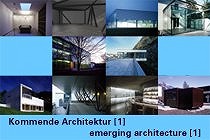
|
Emerging Architecture 1 - Kommende Architektur 1 10 offices Location: Architekturzentrum Wien - Old hall Exhibition: 21 September 2000 - 30 October 2000 Opening Hours: daily 10:00 A.M to 7:00 P.M. Opening: Wednesday 20 September 2000, 7pm Pichler & Traupmann Kundmanngasse 39 A-1030 Vienna A U S T R I A Phone +43 (1) 713 32 03 - 20 Fax +43 (1) 713 32 03 - 13 pichler_traupmann@vienna.at www.pxt.at Christoph Pichler Born in 1964 in Vienna. 1983 - 1989 studied at the College of Applied Arts in Vienna, Master-class Prof. Holzbauer. 1990 - 1992 studied architecture at the Graduate School of Design, Harvard University, USA. 1992 - 1996 Assistant at the TU Vienna at the Institute for Structural Engineering, Prof. Richter. Since 1996, Lecturer at the TU Vienna. Johann Traupmann Born in 1958 in Güssing/Burgenland. 1977 - 1983 studied Theology at the Catholic Theological Faculty at the University of Vienna. 1981 - 1987 studied at the College of Applied Arts in Vienna, Master-class Prof. Holzbauer. 1992 - 1998 Lecturer at the College of Applied Arts. 1993 Lecturer at the Catholic Theological College Linz for Art and Church Architecture, Prof. Rombold. Since 1998 Assistant at the College of Applied Arts in Vienna, Master-class Prof. Hecker. Buildings, Projects (selection): 1994 - 1996 Haus Berger, Burgenland 1995 - 1997 Haus Drexler, Burgenland. (Austrian Cement Industry Prize) 1997 - 1998 Ebner’s Glazier’s Workshop (Builder’s prize) 1998 - 1999 Haus Roubin and Haus Melchart, Vienna One of the most characteristic features of 20th century modernism is the concept of the "flowing space". Control of nature as a result of technology and new building materials made it unnecessary to separate the inner world of the habitat from the more or less friendly outside world. Living quarters and the natural environment should interpenetrate; that was the message from Frank Lloyd Wright, Mies van der Rohe, Richard Neutra and others. The break-up of old tectonic of solid walls and ceilings led in the case of the most radical of buildings to free-floating, autonomous walls and roof areas in conjunction with extensive glazing. The potential of such ideas seemed to be exhausted for decades and was eventually questioned in the face of environmental problems raised by the creation of more compact building concepts. Pichler & Traupmann grasp these threads anew and develop them into a new, more complex pattern. Not only should space, according to them, be capable of flowing from both inside out and outside in, the spatial shell should also awaken from its autonomous state and architecturally merge inside and out in an analogous, flowing gesture. In addition, they go beyond classical modernism‘s platonic entities and structural homogeneity in the direction of dynamic duality. What already existed with Mies van der Rohe - the contrast of the purist base with a strict suspended roof - Pichler & Traupmann develop in their own way further. They create a relief of buildings on the top of the existing terrain and place the figure of a complex folded exterior upon it, one that only touches the foundation at certain points and which materializes the opening, filtering and intensity of the relationship between rooms. The glazed areas and walls between the sculpted plinth and the exterior are transparent membranes which regulate the climate. Folding planes into spaces has been a hotly-disputed subject for a number of years in the avant-garde, mostly associated with overdoing Euclidean geometry to polymorph and amorph constructions; crumpled potatoes and Moebius strips are apparently highly topical. Pichler & Traupmann don‘t go that far. Their folds make the old opposites of wall and ceiling or wall and door/window equal. The values of horizontal/vertical, bottom/top remain, however, essential to them and therefore, as they strongly argue, maintaining the dialectic of rectangular forms more clearly expresses the liquification of their opposites than any other way. [...] |
 |
|
|
|
Current Preview Permanent Exhibition Emerging Architecture 1 - Kommende Architektur 1 Press Release The 10 offices * Bulant & Wailzer * Peter Ebner * Geiswinkler & Geiswinkler * Kaufmann 96 GmbH * Rainer Köberl * lichtblau . wagner * Marte.Marte * Pichler & Traupmann * Riepl Riepl * Splitterwerk Gallery: Emerging Architecture 1 - Kommende Architektur 1 E-Shop Products: Book: Emerging Architecture 1 / Kommende Architektur 1 DVD: Emerging Architecture 1 - Kommende Architektur 1 Information: Ines Purtauf Tel.: +43 (1) 522 31 15 - 25 Fax: +43 (1) 522 31 17 Email: purtauf@azw.at |
| © Architekturzentrum Wien 2025 |
||



